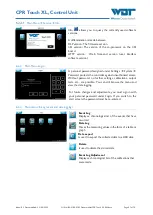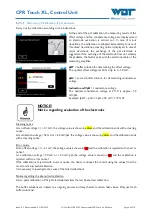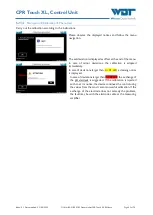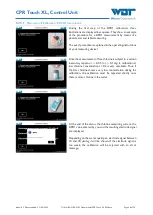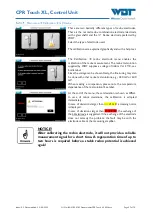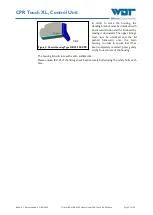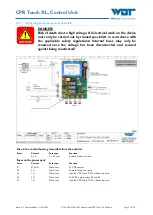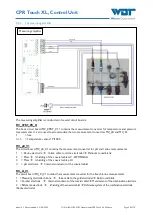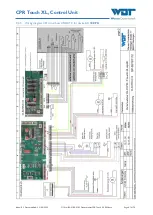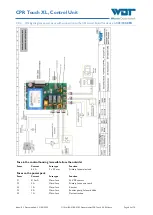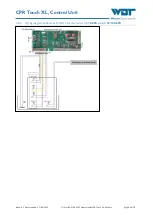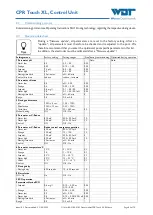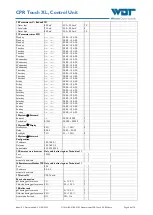
CPR Touch XL, Control Unit
Index: 03 Date modified: 22/06/2022
OI No.: BA MR 001-03 Steuereinheit CPR Touch XL EN.docx
Page 53 of 70
Only with wall-mounted devices
11.
pH leakage ALARM:
The hose rupture sensor on
the pH dosing pump has
triggered. The pH dosing is
stopped.
Check the pump’s dosing hose and renew, if
necessary; if it is OK, check the dosing valve for
blockage.
12.
Disinfectant leakage
ALARM: (only for type 2S)
The hose rupture sensor on
the disinfection dosing pump
has triggered. The disinfection
dosing is stopped.
Check the pump’s dosing hose and renew, if
necessary; if it is OK, check the dosing valve for
blockage.
Only with Granudos
13.
Pressure minimum
ALARM:
The flow pressure at the booster
pump is too low
Dosing is stopped. The booster
pump has been deactivated.
1. Supply pressure too low
2. Booster pump faulty
3. Pressure switch faulty
4. Set a lower response pressure at the pressure
switch
5. Prefilter dirty
6. Inlet blocked
14.
Flushing tub level
minimum ALARM:
The water level in the flushing tub is
low; more water is suctioned off
than runs into the flushing tub
through the floating valve.
Dosing is stopped. The booster
pump has been deactivated.
1. Floating valve function:
a)
The water inlet should gently follow the
float’s movement. If OK, calibrate the water
level. See OI Dosing unit, chapter
Commissioning
b)
If this is not the case, insert a new
diaphragm in the floating valve.
2. Insert a pinhole aperture with a smaller drill
hole
3. Prefilter (Pos. 9) dirty
clean
15.
Flushing tub level
maximum ALARM:
The water level in the flushing tub is
too high, less water is siphoned off
than is flowing into the flushing tub
through the floating valve.
Dosing is stopped. The booster
pump keeps running.
1. If the injector’s suction capacity is OK:
a)
Floating valve function:
The water inlet should gently follow the
float’s movement. If OK, calibrate the water
level. See OI Dosing unit, chapter
Commissioning
b)
If this is not the case, insert a new
diaphragm in the floating valve.
2.
If the suction capacity is not sufficient, see under
fault display
"Suction pipe flow minimum
ALARM"
16.
Suction pipe flow
minimum ALARM: (only with
GR)
The water flow in the suction pipe is
too low. The switch body of the
flow switch does not rise, the switch
LED lights up.
Dosing is stopped. The booster
pump keeps running.
1.
Check booster pump functioning.
2.
Prefilter dirty
clean
3.
Blocked suction opening in the flushing tub
4.
There may be particles in the nozzle or in the
suction pipe, due to particles entering during
installation or from the chlorine
5.
Insert a pinhole aperture with a larger drill hole
or remove it entirely
6.
Blocked non-return valve at the buffer tank
7.
Diffuser worn out, if D > 6.5mm, replace
diffuser
17.
Chlorine dosing
monitor in cyclone ALARM:
(Only with GR)
The optical sensor on the dissolving
cyclone is activated.
The sensor on the cyclone
indicates that during the 2nd
dosing interval, there is
insufficient chlorine in the
cyclone.
1. Fault during dosing:
a)
Clotting in chlorine granulate
b)
Dosing screw blocked due to poor chlorine
quality (too fine, moist)
2. The dosing motor is defective.
3. Calibrate the optical sensor.
18.
Chlorine dosing motor
fuse ALARM:
The disinfection dosing stops.
The booster pump keeps
running.
Check chlorine motor for blockages, remove
blockage, if necessary, and renew the fuse.



